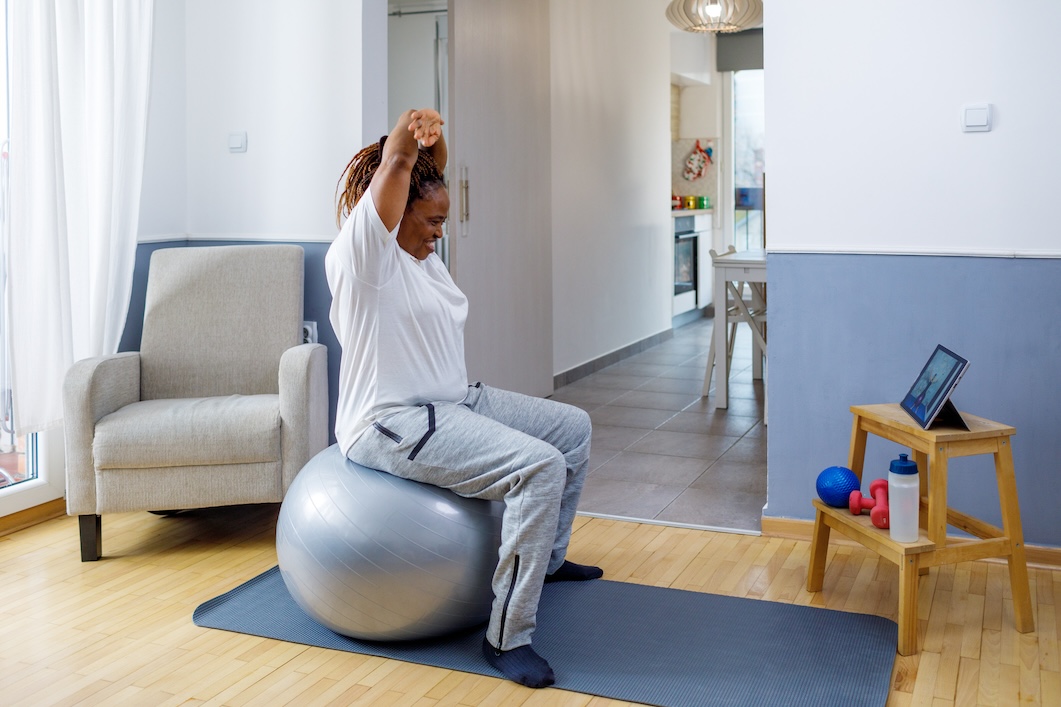It can be tough getting to the gym. Sometimes we don’t have the budget and other times we might worry about sharing our space with others while we exercise. Enter the home workout. The internet has enabled almost every type of fitness activity imaginable to be streamed into our homes. Use online resources wisely, and they can help us progress towards our goals, use them without caution and we can end up injured.
Your level of fitness and general health will determine what types of home workouts are suitable for you. It’s recommended you consult your GP before starting a new exercise regime. If you’re new to exercise, always choose beginner workouts and start slowly. You can build duration and intensity over time as you progress.
- Build your cardio fitness by walking, jogging and skipping – you can do this on the spot if space is an issue.
- Build strength and mobility with pushing and pulling movements like push ups and pull ups, as well as other bodyweight exercises like squats and lunges.
Great workouts that offer modification for beginners to look up online include: HIIT, aerobics, zumba and yoga. When starting out with home workouts, whether it’s online or with DVDs, it’s helpful to give some thought to the following points.
Your goal. Why are you working out at home? What do you want to achieve? This way, you can plan the activities you choose and the frequency that you do them to progress towards your goals.
Set out your space. The beauty of exercising at home is that you really don’t need a lot of space. As long as there’s somewhere you can unroll a yoga mat, you’ve got enough space for lots of workouts. Of course, if you’ve room to move, all the better as you can incorporate different workouts, but small spaces aren’t a problem. Something that can be an issue is noise levels, especially if you live in a flat or shared housing or you work shifts which mean you exercise whilst others sleep. Luckily, there’s provision online for these circumstances. Simply pop ‘no noise’, ‘apartment’ or ‘flat friendly’ after your search for a workout and suitable options will come up. You could also use wireless headphones to listen to the video to further decrease sound others will hear. Make sure the area is well lit and free from hazards that could cause injury.
Make a routine. Because you’re getting active at home, you can do it any time. But will you? You’re much more likely to actually exercise if it’s in your diary as a gym class would be. A regular routine helps us to stay motivated and committed and ensures household chores and TV boxsets don’t steal our precious exercise time from us.
Equipment. When starting out, you really don’t need much other than maybe a comfortable exercise/yoga mat – and even then, you can use a towel for mat work if you’re really stuck. We can utilise things found around the house for workouts, like canned foods as hand weights and a jog up and down the stairs for a warm up. If you enjoy working out at home, you might want to build up a small selection of equipment like a kettlebell, skipping rope, dumbbells and resistance bands which can be used to increase the intensity and options in a workout.
Most types of exercise benefit from the correct form and technique which can be learned more easily in a class, so if you’d like to do strength training, high impact activities or alignment based practices like yoga and pilates, it’s certainly worth considering taking a few live classes to make sure your foundations are correct.
Whether you’re at a class or doing a session online, it’s likely you’ll hear some terms you’re unfamiliar with. Take a look at Brushing up on exercise terms to get the lingo.
Whatever your fitness level, budget and space available—and whether it’s your sole source of exercise or supplementing other activities you do— there are many ways to get moving and boost your health and wellbeing in the process. What are you waiting for?
